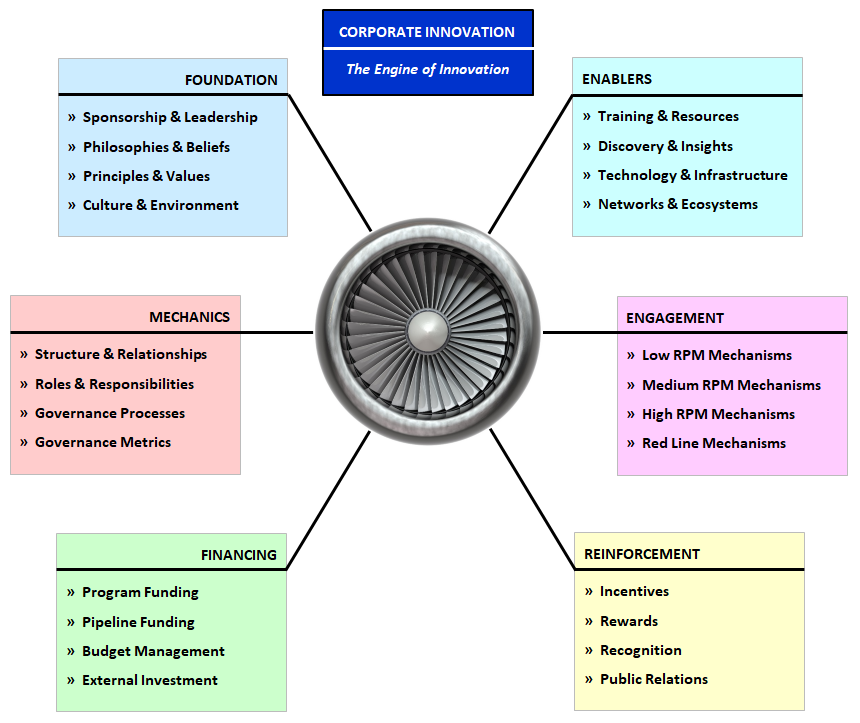The Responsive Innovation Engine (Corporate Innovation) Architecture (Responsive IE) is Legacy Innovation Group's comprehensive and proprietary model for Corporate Innovation.
We created this architecture because Corporate Innovation has to deliver. It has to deliver real outcomes that produce real business impact, and it has to do so on a number of different levels. In fact, among the legions of core competencies that businesses are challenged to master, Corporate Innovation is singularly unique in the leadership demands it makes, the cultures it requires, the organizational structures it uses, the roles and responsibilities it calls upon, and the processes it employs — all to ensure a constant flow of open, divergent ideas for new business opportunities.
Because of this, the primary aim of any Corporate Innovation program has to be to create within the business an "engine of innovation" — one with the intelligent power needed to drive continual, effective growth. And yet most organizations struggle when trying to implement this type of enterprise–wide innovation. Their struggles stem from not having a well–designed program with built-in high–level coordination (a situation that more often than not hamstrings their projects). Responsive IE solves this problem. By driving high–level coordination across a broad range of activities, it is an architecture that, when used properly, will in fact create within a business a highly responsive innovation engine.
Responsive IE addresses all of the critical considerations that a Corporate Innovation program must make, such as... the program must demand ownership and full support from the most senior levels of the organization – including the CEO – and must be given a seat at the C Table. The program must teach and instill a culture that embraces uncertainty and change, that fosters exploration and learning – even learning through constrained failure, and that engages a generation of professionals hungry to live out a sense of purpose and meaning. The program must build an unconventional organizational structure that gives life to new types of teams, broadens existing teams, and creates a network of collaborators throughout the organization and beyond. The program must leverage a unique selection of roles and responsibilities to accomplish its aim – at times employing armies of "volunteer" intrapreneurs to get the work done. And the program must implement a very calculated process with well–defined steps, triggers, and loops if it is to achieve its goal of delivering sustainable new growth for the business. And it must do all of this in a way that is completely tailored to the business. Responsive IE makes this happen.
The Responsive Innovation Engine Architecture defines twenty-one elements that every successful Corporate Innovation program must address. Each element is distinct and must be well–considered and well–designed if it is to align to the business, its strategies, its markets, and its opportunities. The twenty-one elements are clustered into six groups, as follows.

Sponsorship & Leadership — The imperative that ownership and leadership of the Corporate Innovation program begins with the company's executive leadership team.
Philosophies & Beliefs — A fundamentally different set of philosophies about business and innovation that stand to drive truly impactful innovations day–in and day–out.
Principles & Values — The organization's embrace of ideals that value innovation for reasons of strategy and purpose, and operating principles that reflect this.
Culture & Environment — The underlying organizational culture and environment needed to nurture and sustain Corporate Innovation.
Structure & Relationships — The organizational structures and relationships needed to facilitate Corporate Innovation.
Roles & Responsibilities — The roles and responsibilities needed to successfully carry out a healthy Corporate Innovation program.
Governance Processes — The processes used to operate and govern Corporate Innovation across a broad array of domains.
Governance Metrics — The specific metrics used at various stages to green light new concepts for evaluation / development / commercialization, and the specific KPIs used to assess the impact & effectiveness of the overall innovation program.
Program Funding — The allocation of an operating budget needed to operate an effective Corporate Innovation program, including its various resources for the business.
Pipeline Funding — The allocation of investment budget(s) needed to finance the research, development, and launch of new innovations for the business.
Budget Management — The budget management practices used to manage the Corporate Innovation program's investment spending.
External Investment — The funds set aside and managed for investing in external (inorganic) innovation pursuits.
Training & Resources — The provision of appropriate training and resources to teach participants how to think like innovators and have the insights, tools, mentors, and places they need to be successful as innovators.
Discovery & Insights — The mechanisms and resources in place for discovery and insights-mining work, including research to uncover unmet needs in the market, and futuring / trends analysis to uncover emerging new opportunities for innovation.
Technology & Infrastructure — The technology investment in creative design tools and capital equipment, and the infrastructure investment in labs and research spaces needed to experiment and test out new innovations.
Networks & Ecosystems — The support system of relationships among a wide array of internal and external partners, providers, investors, customers, and others – all aligning around new ways of working so as to deliver new business models and new value propositions.
Engagement — The mechanisms used to drive organizational engagement in the Corporate Innovation program in order to feed its Innovation Pipeline.
There are numerous mechanisms a business can use, each one of which revs the innovation engine at a particular speed — Low RPM, Medium RPM, High RPM, or Redline.
Incentives — The use of appropriate incentives to help incentive people to engage in the Corporate Innovation program and it various campaigns, sending a clear message that the business places a high value on innovation.
Rewards — The use of tangible rewards (for both teams and individuals) to reinforce the business' "value of innovation" message and thereby sustain ongoing engagement in the program.
Recognition — The use of broad recognition (for individuals, teams, and projects) to reinforce the business' "value of innovation" message and thereby sustain ongoing engagement in the program.
Public Relations — The communications used to build and sustain support for the Corporate Innovation program, both inside and outside the business.
Additional details of the Innovation Management process (which resides within, and is a key piece of, the Corporate Innovation program) are covered in our Market Stream Innovation Management System. Similarly, formulating the actual portfolio of innovations to pursue is covered in our GR5 Growth Strategy Playbook. These tools are designed to complement Responsive IE and one another.
The Responsive Innovation Engine Architecture is a large and comprehensive model.
If you are interested in studying the model in its full detail, you may do so here... The Responsive IE Architecture In Detail — Twenty-One Elements.
No two Corporate Innovation programs will be exactly alike – nor should they be. Each program must be custom–tailored to fit the needs and strategies of the business – and its external realities.
Therefore, when it comes to designing the program and establishing the details of these twenty-one elements, each element must be carefully examined and considered in depth, so that in each case your organization can decide what will work best for its particular situation. The organization's current level of innovation maturity will also play an important role in deciding where to go next with each element.
In almost all cases, designing a Corporate Innovation program will benefit from the perspective of an outside third party who has experience across a broad range of industries and businesses evaluating organizations and designing innovation programs that most effectively fit their needs. This tends to yield far better long term results than does going it alone.
Responsive IE provides the basis for our consulting work in Corporate Innovation (in which we custom design Corporate Innovation programs for clients using this model as the foundation). To learn more, please see our Corporate Innovation Consulting page, or to engage us in this capacity, refer to our Management Practice Engagement page.
Responsive IE and Market Stream IM (together) provide the basis for our Corporate Innovation and Innovation Management training course. To learn more, please see our Corporate Innovation & Innovation Management Course page, or to engage us in this capacity, refer to our Training Engagement page.

CEOs come and CEOs go. Some are excellent. They generally ‘get it’. Others not so much. They really ‘don't get it’. What makes the difference between these?
READ MORE
There's an insidious debate that's bounced around for probably the better part of twenty years now. It's the debate of whether or not ‘innovation is everyone's job’...
READ MORE
Innovation Spaces – which can refer to any space intentionally designed to foster and facilitate good innovation work – come in all sorts, shapes, and sizes...
READ MOREWe partner with committed business leaders to make their organizations the driving forces in their markets.
CONTACT USSign up for our newsletter.
NEWSLETTER SIGN-UP